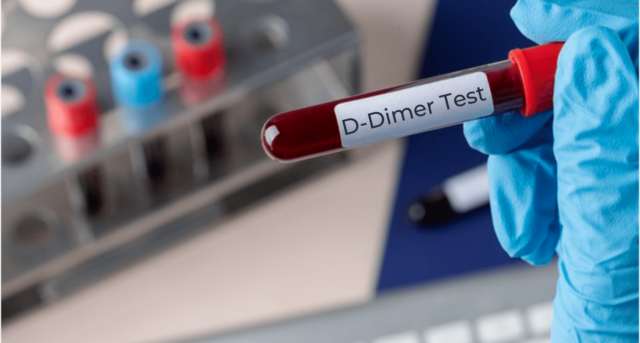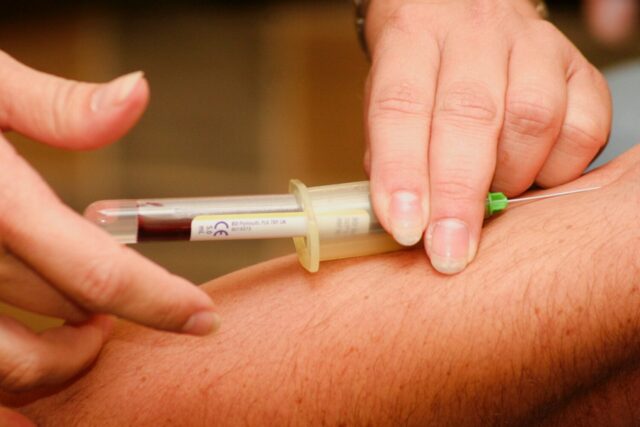
D-dimer is a protein fragment produced when a blood clot gets dissolved in the body. Blood clots form when a blood vessel is damaged, whether by an injury, by atherosclerosis, or when blood flow is restricted, such as by a vessel being compressed for a long time.
Doctors use the D-dimer test to check the level of D-dimer in the blood, to figure out whether you might have a blood clot. D-dimer test is also called a fragment D-dimer test or fibrin degradation fragment test.
What is the D-Dimer test?

A blood test that a doctor uses to rule out the presence of a serious blood clot is the D-dimer test. This test measures the D-dimer, a type of protein that the body produces to break down a blood clot. Normally, it is detectable at a very low level or undetectable unless the body is forming and breaking down blood clots.
If a person gets a cut, the body takes many steps to make blood clump up. This is a normal part of healing and without it, a person may keep bleeding and may have a serious problem to deal with. When the bleeding stops, you don’t need the clot anymore. Therefore, the body takes a series of steps in the other direction and breaks the clot down.
In the end, there will be some leftover substances floating around in the blood. One among the leftovers is D-dimer. Normally, it goes away with a little time. If a person has a major clot like deep vein thrombosis (DVT), they can get high levels of D-dimer in their blood. With deep vein thrombosis, one may have a clot deep in one of the veins, usually in the legs, and it can lead to serious problems.
Why would I need this test?

The doctor might ask you to take this test if they suspect you have blood clotting problems or if they want to rule them out. Blood clotting problems may include:
- Deep vein thrombosis (DVT) – A blood clot deep inside a vein. And these clots usually affect the lower legs, however, they can also happen in other parts of the body.
- Pulmonary embolism (PE) – This is a blockage in an artery in the lungs. Usually, it happens when a blood clot in another part of the body breaks loose and travels to the lungs. DVT clot is the common cause of pulmonary embolism.
- Disseminated intravascular coagulation (DIC) – This condition causes too many blood clots to form throughout the body, and can cause organ damage and other complications. DIC can also be caused by traumatic injuries or certain types of cancers or infections.
- A stroke is a blockage in the blood supply to the brain.
- Blood coagulation is caused by the venom of certain species of snake, such as a brown snake.
A positive D-dimer test does not mean you have a blood clot. Additional tests will be needed to check for that. A person has higher odds of a clot with:
- Clotting disease that you’re born with
- Major surgery (like knee replacement)
- Major injury (like a broken leg)
- Long periods of lying down or sitting, such as hospital stay or a long plane ride
- Pregnancy
- Certain cancers
- Antiphospholipid syndrome (a disease in the immune system)
Symptoms of a blood clot
- Leg swelling, pain, or tenderness
- Redness or discoloration of the skin
- Trouble breathing
- Chest pain
- Rapid heartbeat
- Coughing with blood
- Bleeding gums
- Nausea
- Seizures
- Severe stomach ache
- Muscle pain
If you experience any of the above symptoms, then get tested for D-Dimer levels. DxSaver.com is a diagnostic listing provider that caters you to all the labs and prices that provide D-Dimer tests all in one place.
What happens during the D-Dimer test?

Any special preparations aren’t required for a D-dimer test. Doctors use a thin needle to take a small amount of blood. People may feel a pinch or stinging when the needle goes in. It is common to get some soreness or a bruise where the blood is taken.
What do the results mean?
When the result is negative or low/normal D-dimer levels in the blood, you most likely won’t have a problem with blood clots, like DVT. But when the result is higher than the normal level, you will need more testing to see if you have a blood clot. As this test can only help rule them out, it cannot confirm DVT or PE or show where the clot is located or what type of clotting disorder a person has. And, high levels may not be always caused by clotting problems. Other conditions which can increase the D-dimer levels may include heart disease, pregnancy, and recent surgery.
D-Dimer levels
The D-dimer level is “Normal” when the result is less than 0.50 or <500 ng/mL and “Abnormal” when the result is above 0.50 or >500 ng/mL. It is important to note that different labs may do the test differently, so the normal level may vary.
Why is the D-Dimer high?

Many treatments, diseases, and lifestyle factors can increase the D-dimer levels. Often people with blood clots have one or more of the risk factors, it may include:
- Heart disease: A person who has had a heart attack has higher levels of D-dimer and is at higher risk of future blood clots.
Cancer treatment: Certain breast cancer drugs and chemotherapy can increase the risk of blood clots. - Treatment with estrogen: Hormone replacement therapy and birth control pills can increase the risk of DVT and PE.
- Surgery: People who have had major surgery, like a hip or knee replacement are also at a higher risk of a blood clot.
- Infectious diseases: Diseases like COVID-19 and pneumonia can cause inflammation and trigger blood clots.
- Liver cirrhosis: Patients with severe liver disease have a higher risk of clots in the large vein of the liver.
Other risk factors may include:
- People over 60 years of age
- Cigarette smoking
- Women have higher levels of D-dimer compared to men
- Obesity
- Sedentary lifestyle
Other tests
Doctors may also recommend other tests to make sure you don’t have DVT or PE. They may include:
- Other blood tests to check if a person has a bleeding disorder.
- Ultrasonography is a test that uses high-frequency sound waves to take pictures of blood vessels, tissues, and organs.
- A ventilation-perfusion lung scan uses a radioactive substance to help doctors see if air and blood can move through the lungs.
- In computed tomography angiography, you will receive an infusion of a special dye. The doctors will use a CT scan to take high-definition pictures from different angles. And dye lights up the tissues & blood vessels they need to check for blood clots.









